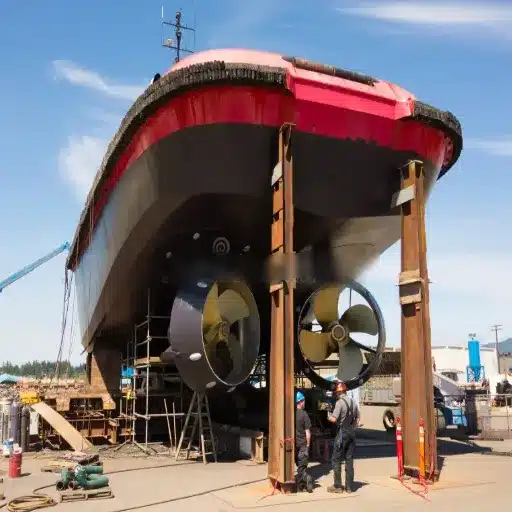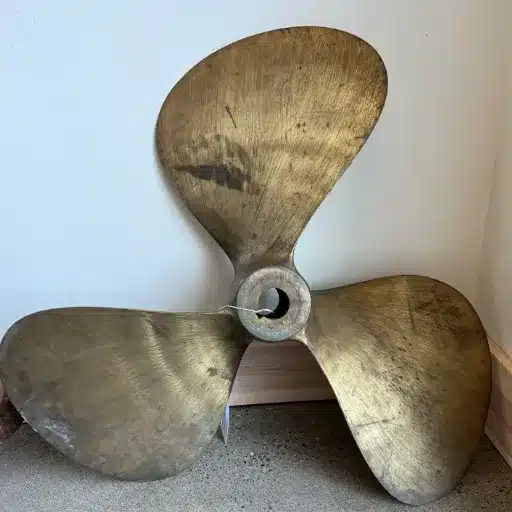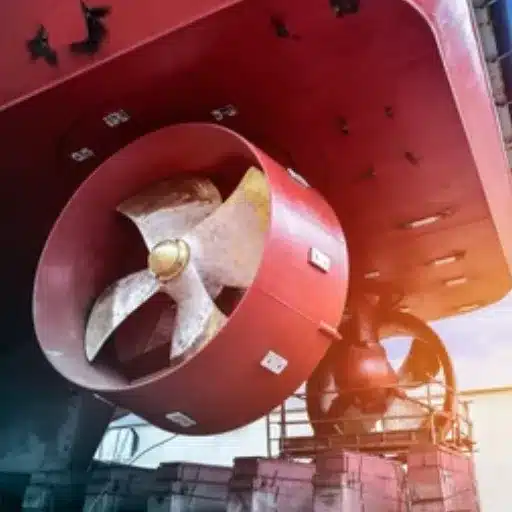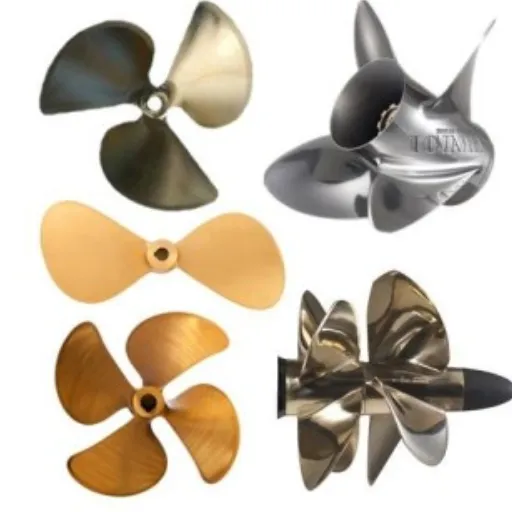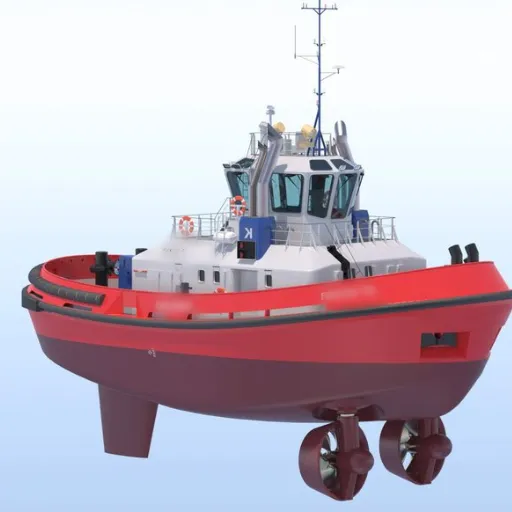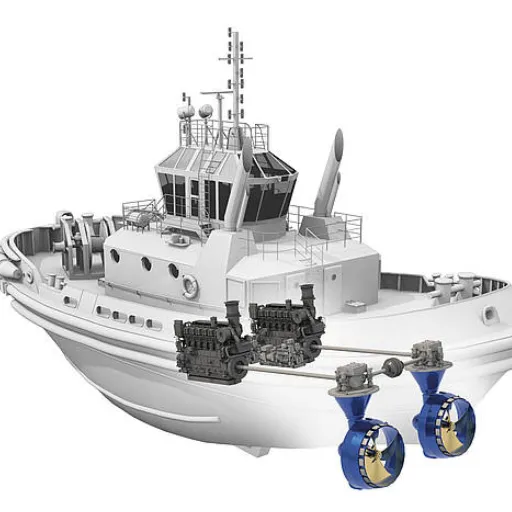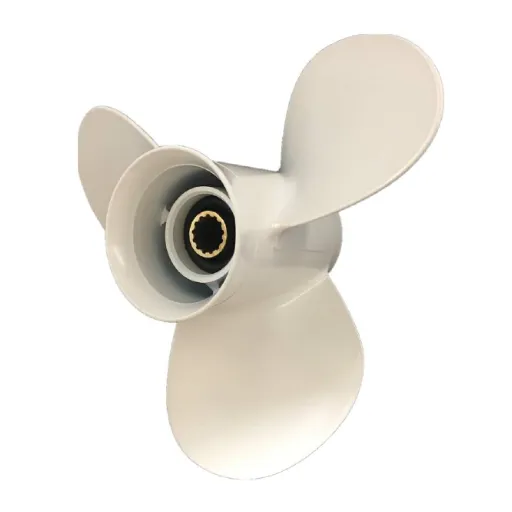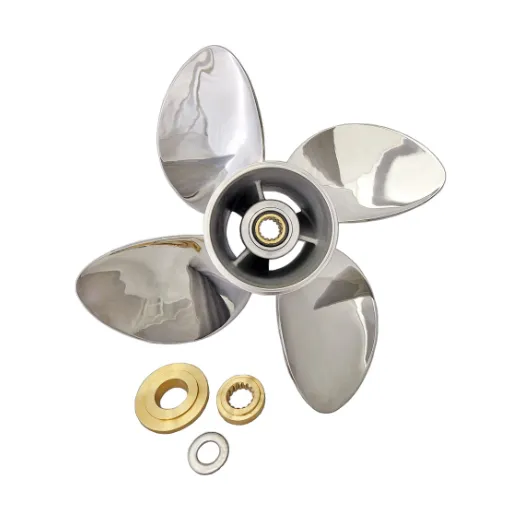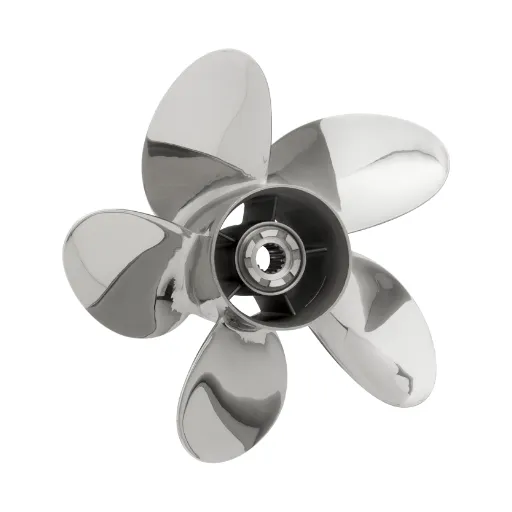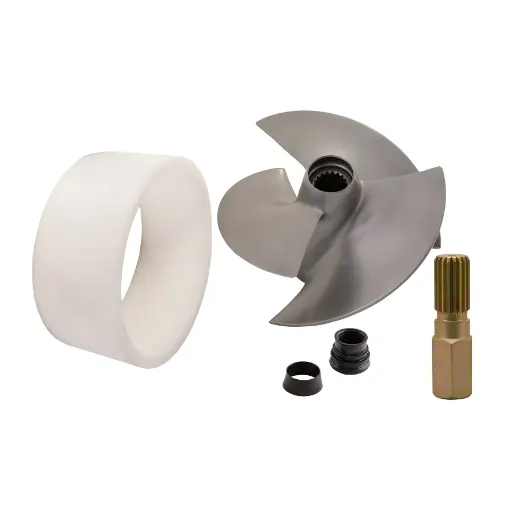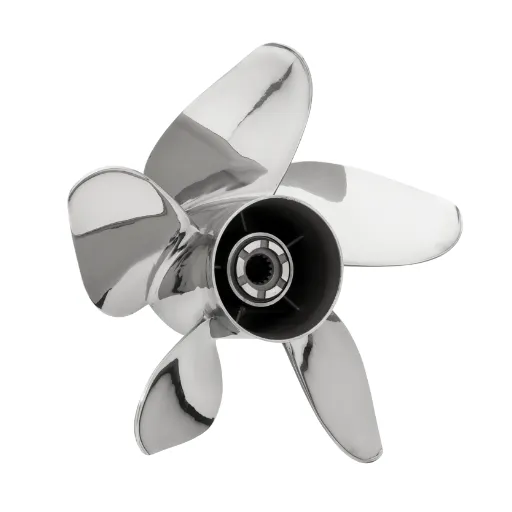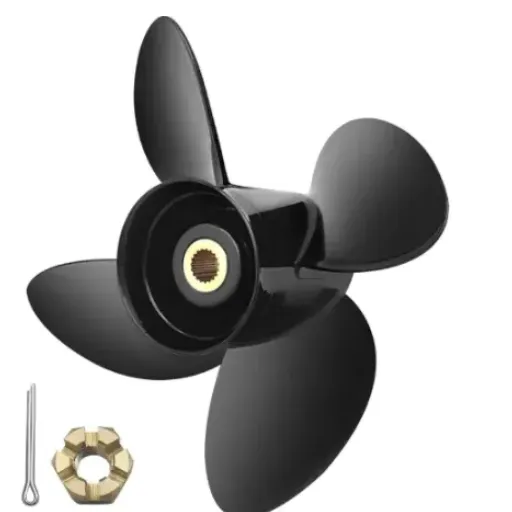Selecting an appropriate propeller for a towboat is a crucial decision, as it immediately affects efficiency, performance, and operating costs. To that effect, engineering aspects, with a slight emphasis on the propeller, in 2025 will make it seem like a range of fresh choices serving different operational requirements. This guide will walk you through all the primary considerations to help you choose the right tugboat propeller, including propulsion technologies, fuel efficiency, thrust optimization, and durability. Whether you’re upgrading an existing vessel or buying a new one, it’s a resource to help you make an informed decision that enhances the vessel’s performance while keeping costs low in the long run. Dive in to check on the present trends, experts’ opinions, and hands-on guidelines in selecting the propeller matching the requirements of your unique tug boat.
Understanding Tug Boat Propellers
What is a Tug Boat Propeller?
The tug boat propeller is a specialized type of marine propeller designed to prevent tug boats from drifting into hazards and to tow, push, or assist larger vessels in tight or treacherous waterways. These propel at high thrust with a low-speed level that assures good performance under heavy loading. Usually, they are made out of bronze, stainless steel, or nickel-aluminum bronze, which can withstand the corrosiveness of the marine atmosphere and the continuous operational stress.
Generally, tugboat propellers have a high blade area ratio to maximize thrust efficiency. The design parameters, including diameter, pitch, number of blades, and skew, are precisely calculated to optimize operational characteristics for specific performance-related operations, such as low-speed towing and precise maneuvering. Furthermore, modern computer-aided techniques can further optimize propeller designs to reduce cavitation and improve fuel efficiency, ultimately enhancing overall performance.
Generally speaking, tug boat propellers prioritize reliability and longevity by understanding precisely what is imposed on a tug boat propeller, including the waters navigated, load conditions, and duty cycles. With data-driven design techniques and stringent testing measures, manufacturers can refine such designs to meet the highly specialized needs of tugboat operations.
Types of Tug Boat Propellers
Tugboat propellers are specially designed for thrust, maneuverability, and durability in harsh operating environments. The main types of propellers installed on tugboats include fixed-pitch, controllable-pitch propellers, and azimuth thrusters.
Fixed-Pitch Propeller (FPP)
The blades of fixed-pitch propellers are fixed in position and set to a known angle. They are considered to be very rugged and simple in design, thus offering reliability in harsh working conditions. They would be able to develop maximum thrust under steady operational conditions. Still, when a sudden change in power or direction is needed, fines might be working against their time. They are mainly used where tugs are working under predictable, steady workloads.
Controllable-Pitch Propellers (CPPs)
These propellers give the possibility to adjust the blade angles dynamically throughout operation. Consequently, variable thrust can be developed according to the circumstances, thereby ensuring improved fuel economy. This makes CPPs favorable for tug boats subjected to frequent changes in load or direction due to changing conditions. The systems enable the instant application of reverse thrust without requiring the engines to be reversed or stopped.
Azimuth Thrusters
Azimuth thrusters are propulsion systems that allow the entire propeller unit to rotate through 360 degrees, providing excellent maneuverability. This is well-suited for harbor tugs and other vessels that require precise navigation in confined spaces. Azimuth thrusters are often fitted with a ducted or Kort nozzle that serves to improve thrust, thereby improving the towing of heavy loads.
Selection Criteria: Types of propellers are generally selected based on the working conditions to which they are subjected. Choices depend on additional factors, such as the bollard pull required, the type of maneuvering needed, and considerations regarding fuel efficiency.
Importance of Propeller Designs in Tug Boats
The design of tug boat propellers is of prime importance when it comes to operational capacity, durability, and working under severe operational conditions. Tug boats require lots of bollard pulls to escort big vessels, whether towing or guiding them. Hence it imparts an even bigger need for the optimization of the propeller. High-efficiency configurations are typically selected to maximize thrust and minimize cavitation. These include Kaplan and fixed-pitch propellers. Engineers today, thanks to the significant advantage of computer-aided CFD (computational fluid dynamics) modeling, can simulate and improve propeller designs to achieve excellent water flow and reduced vibration during operation.
Performance Boost: Studies have shown that a well-optimized propeller with the Kort nozzle can increase the thrust efficiency by as much as 30% compared to an open propeller in similar situations.
Maneuverability is another crucial consideration arising from aspects of propeller design, especially in highly dynamic areas such as congested harbors. By being able to rotate the propeller and rudder combination through 360 degrees, azimuthing drives have become very popular for their reasonable control and fine positioning capabilities.
Modern materials for propellers, such as high-temperature alloys or composite materials, are developed to withstand the long-life stresses and corrosive environments of marine environments introduced by maintenance and operational forces. In combination with the novel maintenance strategies, these materials reduce downtime and lower operating costs, thereby establishing an advanced design for the propeller as a key feature for tug performance.
Key Specifications of Tug Boat Propellers
Diameter and Pitch: Their Effect on Performance
Diameter and pitch, the parameters of a tug boat’s propeller, are of utmost importance in terms of gross performance, efficiency, and thrust. The diameter, measured by the extreme edges of the propeller blades, is essentially the distance through which water is displaced on one complete rotation. Typically, a large diameter produces more thrust, making it applicable in towing and maneuvering applications, where low speed and high power are predominant. On the contrary, overly large diameter sizes tend to create more drag and hinder efficiency due to cavitation or spatial constraints in the propulsion system design.
| Parameter | Large Diameter | Small Diameter |
|---|---|---|
| Thrust Generation | Higher thrust output | Lower thrust output |
| Drag | Increased drag | Reduced drag |
| Application | Heavy towing operations | High-speed applications |
Pitch being the implications of the distance a propeller would theoretically travel with one revolution in perfect conditions-no slippage. The greater the pitch, the greater the displacement of water, and hence higher speed; but the higher the pitch also requires an engine with much more power, which may not favor fuel economy. A lower pitch represents, therefore, a configuration of power maximization at lower speeds, and this is usually the case in tug boat operations. When both diameter and pitch are accurately calibrated and do not contradict the engine’s capabilities and the hull’s dynamics, maximum propulsion efficiency is ensured during tug operation. For instance, in heavy-duty coastal towing of a tug boat, there shall be a demand for a wonderful tuning of the propeller configuration, large diameter with moderate pitch, to obtain the right thrust and maneuvering capability within the engine performance parameter. Hence, these specifications should be taken seriously in order to achieve the highest operational performance.
Blade Design Considerations for Efficiency
Designing efficient blades is essential to achieving maximum system efficiency and performance in marine propulsion. Hence, from an engineering standpoint, considerations must be given to various factors affecting hydrodynamic performance, such as the blade’s surface area, chord length, and aspect ratio. For example, blades with high efficiency usually possess slender profiles with low drag and are thereby limited by cavitation, these characteristics being conditioned by the speed and loading of the blade.
- Surface Area: Optimized to balance thrust generation and drag resistance
- Chord Length: Affects the hydrodynamic efficiency and cavitation characteristics
- Aspect Ratio: Influences the overall performance and structural integrity
- Skewed and Twisted Geometry: Reduces noise and vibration for better operational efficiency
With continuous advances in the field of CFD, it has become possible to perform fine simulations to analyze the performance of blades under specific conditions and acquire data on the generated thrust, required torque, or flow patterns. These days, blade designs are typically made from materials that require high strength and corrosion resistance, such as nickel-aluminum bronze alloys or composites, to provide durability to the substrate under severe marine conditions while reducing material fatigue. Apart from the corrosion resistance property of marine alloys, the incorporation of skewed and twisted blade geometry aids noise reduction and vibration minimization for better operational efficiency and passenger comfort in naval architecture.
Understanding Propulsion Technology in Modern Tugboats
Modern tugboats depend heavily on advanced propulsion technology for optimal power and maneuverability. Among the propulsion systems commonly used in present-day tugboats are azimuth thrusters. With such a system, propulsion units are capable of rotating a full 360 degrees, thereby generating thrust in any direction and offering the utmost control. These thrusters are typically paired with variable-pitch propellers, which enable the operator to adjust thrust by altering the pitch angle in response to changes in load conditions. A typical high-power azimuth thruster can generate thrust in excess of 5,000 kW, thus enabling tugboats to carry out escorting and berthing work efficiently even under adverse weather and strong current conditions.
Hybrid Propulsion Systems
Hybrid propulsion systems rank among the most attractive developments in the field. By combining the options of traditional diesel engines with electric motors, the hybrid system achieves energy efficiency while reducing emissions to comply with stringent environmental laws. Advanced models have the scope to accommodate energy recovery systems, wherein excess energy produced while braking or idling is recycled.
CFD Optimization
Performance optimization enables the maximum application of CFD modeling within the propulsion system. CFD simulations are used to enhance hull-propeller interactions and mitigate cavitation initiated by propeller blades, resulting in reduced energy loss and extended component life.
The inclusion of these new technologies tests the frontiers of designing modern tugboat propulsion toward greener, more efficient, and responsive systems.
Popular Tug Boat Propeller Brands and Manufacturers
Leading Manufacturers of Tug Boat Propeller
The tugboat propulsion industry is supported by several notable manufacturers, renowned for providing innovative and reliable propeller systems.
Rolls-Royce Marine
With an innovation edge for marine propulsion technology, Rolls-Royce Marine has developed solutions for very efficient propellers. Their controllable pitch propellers (CPPs) and fixed pitch propellers (FPPs) are designed for low hydrodynamic drag, thereby ensuring high fuel efficiency and improved vessel performance. Rolls-Royce also utilizes computational fluid dynamics (CFD) in the design process to ensure desirable propulsion characteristics while minimizing cavitation potential.
Schottel GmbH
Schottel is recognized as a pioneer in the manufacture of azimuth propulsion systems for tugboats. Its product range includes the most modern propulsion devices, viz., the Schottel Rudderpropeller (SRP), which guarantees enhanced maneuverability and power capacity. The brand emphasizes rugged use and precision engineering, enabling tugboats to perform efficiently in harsh environments.
Wärtsilä Marine Solutions
As a prominent name in sustainable propulsion systems, they design propellers and integrated solutions to reduce emissions and energy consumption. Their solutions are high-end engineering solutions that merge the latest technologies, such as super-performance nozzles and customized blade designs, to serve the application with utmost performance under a variety of operating conditions.
Kongsberg Maritime
Kongsberg manufactures propulsion systems focusing on fine control and operational efficiency. Controllable pitch, fixed pitch, and azimuth propulsion systems are supplied in accordance with the needs of various tug classes. Intelligent propulsion systems from Kongsberg equip tugboats with enhanced capabilities for control and compliance with environmental regulations.
Thrustmaster of Texas
Thrustmaster specializes in marine heavy-duty propulsion systems, including deck-mounted azimuth thrusters and tunnel thrusters. These systems are all designed for maximum reliability and power, making them an excellent choice for tugboats that require high bollard pull and exceptional performance in harsh conditions.
These manufacturers are a symbol of innovative demand and engineering excellence for ensuring the relevant standards of efficiency, reliability, and sustainability demanded of modern tugboats by the shipping industry.
Comparative Analysis of Leading Propeller Brands
The manufacturers dominate the marine propeller market due to their offerings of technology, performance, and innovation combinations that address the various needs of the maritime sector. The brands Wärtsilä, Schottel, Rolls-Royce, and Nakashima Propeller have, for the most of their existence, maintained leadership in the domain with efficiency, durability, and customization standards they have set.
| Brand | Specialization | Key Advantage |
|---|---|---|
| Wärtsilä | Fuel efficiency & lifecycle optimization | CPPs with variable thrust systems |
| Schottel | Azimuth propulsion systems | Superior maneuverability & modular design |
| Rolls-Royce | High-performance waterjets & FPPs | Lightweight construction & low noise |
| Nakashima | Precision-engineered propellers | Optimized efficiency & sustainability |
The manufacture of propellers is known for focusing on design aspects that ensure fuel efficiency and optimize lifecycle costs. Their CPPs, however, are designed to meet the requirements of a variable thrust and power system. This condition is critically important for cargoes operating with dynamic operation profiles or for offshore supply vessels. These days, CFD analysis is recognized as an integral part of propeller design analysis, ensuring minimum drag and maximum hydrodynamic performance. Materials for blades are generally forged from high-tensile stainless steel or nickel-aluminum bronze, both of which offer excellent resistance to corrosion and cavitation.
Schottel represents a name that stands for innovation in azimuth propulsion systems. The company has set the standard for maneuverability with its reliable and compact azimuth thrusters. Thus, it stands as the most favored option for tugboats and ferries. Their Rudder Propellers have an intuitive, modular design that makes them easy to maintain and customize. The Smart Operation features are integrated for real-time monitoring of performance parameters, offering operational transparency and supporting predictive maintenance strategies to minimize downtime.
Rolls-Royce concentrates on Kamewa products ranging from high-performance waterjets to FPPs. Design stressors include lightweight construction, advanced hydrodynamics, and low noise levels, which are ideal for naval craft or luxury yachts. Rolls-Royce Propellers are precision-machined to an exacting standard, ensuring smooth and controlled vibration amplitudes for optimal passenger comfort and operational stability. Their highly customizable products offer virtually unlimited flexibility for all types and sizes of ships.
The namesake and pioneer of the marine industry in Japan is renowned for its engineering precision and the most refined engineered warp of propeller blades. Nakashima uses designs supported by state-of-the-art software and CNC machining, transforming their FPPs into propellers with optimized efficiency for a specific hull form and operating conditions. Their greatest attention remained on reducing noise and vibration from cavitation, making their name trustworthy in both commercial shipping and passenger vessels. Moreover, they have invested in coating technologies that help minimize biofouling while maintaining a strict profile in sustainable maritime practice.
Selection Summary: As all major brands innovate and lay claim to technical excellence, the selection of a propeller manufacturer primarily depends on the vessel’s operational requirements. Wärtsilä stands for a bit of everything in terms of fuel efficiency and durability. Schottel offers the best maneuverability for high-precision operations, while Rolls-Royce provides comfort and performance for top-notch applications. Nakashima, on the other hand, is all about optimization and sustainability. Giving due regard to these aspects ensures that the marine professionals receive the best propulsion solution in keeping with the present and future needs of the maritime sector.
Cost Considerations When Choosing a Tug Boat Propeller
Price Range of Tug Boat Propellers
Prices of tugboat propellers vary considerably depending on the size, material, design, and manufacturer. Thus, for a standard fixed-pitch propeller, the individual unit can cost somewhere between $10,000 and $50,000, with the exact cost depending on the vessel’s specifications. For larger and high-performance propellers, such as controllable pitch propellers or customized solutions for specific maritime applications, the prices can exceed $100,000.
| Propeller Type | Price Range | Typical Application |
|---|---|---|
| Standard Fixed-Pitch | $10,000 – $50,000 | General tugboat operations |
| Controllable-Pitch | $50,000 – $100,000+ | Variable load operations |
| Custom High-Performance | $100,000+ | Specialized maritime applications |
Materials play a crucial role in determining the value aspect; premium metals, such as stainless steel and nickel-aluminum-bronze, offer better strength and corrosion resistance and therefore come with a higher price tag. Additionally, manufacturers that have developed and provide advanced hydrodynamics for improved fuel efficiency and reduced cavitation charge their purchasers a premium for their innovations. Thus, potential buyers must consider both the initial cost and increased efficiency for long-term savings and maintenance costs in evaluating the total cost.
Cost vs. Efficiency: A Trade-Off Analysis
When deciding between cost and efficiency, it is crucial to consider both the initial investment and potential operational savings. Materials such as stainless steel or aluminum tend to offer gains in terms of performance, including greater strength, abrasion resistance, and lower maintenance requirements. Therefore, unlike most materials, stainless steel or aluminum usually demands a higher upfront cost, the balance of which is achieved due to fewer instances of equipment replacement in the long run.
Efficiency Gains: In terms of efficiency, enhancing hydrodynamic designs has now been found to provide the best fuel consumption by reducing drag and improving flow characteristics. Studies indicate that fuel efficiency can be increased by almost 15-20% using systems with enhanced geometry, thereby reducing operational costs over a significant period.
To delineate this trade-off, a lifecycle cost analysis can be considered. Higher-quality materials or designs used for the construction of an item lead to greater acquisition costs, which are, however, mitigated by reductions in fuel costs, maintenance intervals, and downtime over an operational timeframe of 5 to 10 years. Decision-makers must conduct a comprehensive cost-benefit analysis based on their own philosophy of use and operating conditions to determine which option is the most economically viable.
Long-Term Value from High-Quality Propellers
High-quality propellers are of utmost importance for long-term operational performance and efficiency in different contexts. Durability, light weight, and resistance to wear caused by long marine exposure are ensured through the use of materials such as carbon fiber composites or corrosion-resistant alloys. They extend the life of a propeller and keep it in working order longer due to the degree to which they resist adverse conditions and attacks.
- Enhanced Durability: Premium materials resist marine corrosion and mechanical stress
- Improved Performance: CAD optimization and CFD simulations ensure maximum thrust efficiency
- Fuel Efficiency: 10-15% improvement in fuel efficiency over traditional propellers
- Reduced Maintenance: Lower vibration and noise levels reduce wear on components
- Environmental Compliance: Meets modern maritime environmental standards
During their operational lifetime, and with a proper maintenance schedule, the selection of an expensive, high-performance propeller, custom-tailored to the vessel type and operating conditions, will translate into tangible benefits: cost savings, operational reliability, and environmental compliance in accordance with today’s maritime standards.
Future Trends in Tug Boat Propeller Technology
2025 Trends: What to Expect in Propeller Engineering
From my perspective, the year 2025 will be a significant milestone in the evolution of Tugboat propeller engineering, marked by developments in sustainability, automation, and materials science. Eco-propeller designs, which aim to enhance energy savings and reduce environmental pollution, will likely take center stage as one of the prominent trends. I feel that propellers would probably feature blade geometries optimized through CFD to maximize thrust and minimize cavitation, thus aiding fuel economy and reducing greenhouse gas emissions. This is in line with extremely stringent environmental regulations existing internationally, making the need to comply something that operators all over the world should not take lightly.
Sustainability
Eco-propeller designs optimized for fuel efficiency and emission reduction
Smart Technology
Real-time monitoring and predictive analytics integration
Advanced Materials
Composite materials and advanced alloys for enhanced performance
Another significant trend I see is the insertion of innovative technologies into propeller systems. Advances in sensor technology and predictive analytics will grant the latest evolution to give real-time monitoring of the propeller’s performance and wear levels. Such systems will provide operationally sound data, helping optimize operations, predict better scheduling of preventive maintenance, and reduce downtime. The digitalization of the propeller system aligns with a broader scope of automation and the industry’s push for so-called “smart” ships.
The final material will likely be ground zero for innovations, composite materials, and advanced alloys, enabling lighter yet more sturdy designs of propellers that must resist rigorous operational demands imposed on them while rendering efficiency and allowing a high level of customization for specific needs of vessels, so that a given propeller will be able to render maximum performance on an operational profile basis. Taken together, I expect that these trends will drive propeller engineering further towards performance, sustainable solutions, and adaptability.
Impact of Automation on Tug Boat Propellers
Automation has largely influenced tug manufacturing and vendor description, both in design and operation. This, from my perspective, has given the automation world precision that was perhaps never achieved with the utmost proficiency in order to obtain an efficient and consistent propeller design. Now, extremely advanced computerized systems ensure control over the wide fluctuations in manufacturing tolerances, which could not have been achieved with manual methods. When surface finish and manufacturing tolerances are adequately controlled, the propulsion efficiency of the propellers increases, and their working life is also prolonged due to a reduction in structural defects.
- Design Precision: Advanced computerized systems ensure optimal manufacturing tolerances
- Real-Time Adjustments: Propulsion control systems adapt to environmental factors instantly
- Performance Monitoring: Continuous tracking of thrust, torque, and rotational speed
- Predictive Maintenance: Advanced sensors monitor condition and predict maintenance needs
Integration of various automated systems in the operation and maintenance of tug boats is another great consideration to keep in mind. Propulsion control systems of the most advanced kind now guarantee that the propellers are operating in accordance with their design specifications, notwithstanding environmental factors or operational demands; by real-time adjustments based on continuous monitoring of parameters such as thrust, torque, and rotational speed, these systems serve to augment either maneuverability or fuel cost savings. This enhances the overall performance of tugboats in demanding situations, such as docking or salvage operations.
Additionally, the automation aspect has a significant impact on the predictive maintenance aspect of tugboat propellers. Advanced sensors coupled with cutting-edge diagnostic software will continually monitor the condition of the propellers and their components, such as wear and tear, before it becomes a critical issue. Operators would then use this information to plan maintenance activities ahead of time, thereby lessening downtime and expensive repairs. In my view, automation enhances performance while also bringing reliability and cost savings to tugboat propeller operations in general.
Environmental Considerations and Sustainable Propulsion Solutions
While considering ecological aspects and sustainable powering of tug boats, my main emphasis goes into reducing the impact on the environment while bearing in mind operational efficiency. By far, the most effective approaches for minimizing impact would be energy-efficient propulsion systems, which could be hybrids or fully electric. Such systems, although very much possible, evade the traditional diesel engine setup; these traditional diesels, in fact, generate a significant amount of greenhouse gases. If engineered with intelligent energy storage systems, such as battery packs, in combination with optimized engine use, the fuel consumption and polluting emissions from tugboats would be significantly reduced.
Alternative Fuels
- LNG (Liquefied Natural Gas)
- Biofuels
- Hydrogen fuel cells
These fuel types burn cleaner and contribute to meeting strict international measures like IMO Tier III.
Emission Control
- Exhaust gas cleaning systems (scrubbers)
- Selective catalytic reduction
- Particulate filters
Advanced technologies to reduce sulfur dioxide and particulate emissions.
Ultimately, enhancing hydrodynamic efficiency through improved hull shapes and propeller arrangements minimizes energy waste during operations. Digital monitoring systems and AI-based optimization algorithms further enhance this solution, enabling continuous operational improvements to ensure sustainability while maintaining high-performance standards in tug operations.
Reference Sources
- The Ultimate Guide to Tug Boat Propellers: Powering Maritime – Discusses factors like vessel size, maneuverability, and marine conditions for selecting tug boat propellers.
- Understanding the Different Types of Boat Propellers – Explains propeller types, including ducted propellers, which are ideal for tugboats.
- How to Choose the Right Mercury Outboard Propeller – Covers propeller designs and their impact on efficiency and performance.
- Click here to read more.
Frequently Asked Questions (FAQs)
What importance does the propeller design assume on a tug boat?
The propeller must be designed for tugboats with the intention of maximizing thrust and ensuring maneuverability. The tugboats often require special marine propulsion systems that enable them to operate in diverse conditions. An adequately designed propeller will, in fact, increase engine efficiency and further overall vessel performance. Manufacturers usually try to select the blade shape and pitch value so that the propeller can turn efficiently and, consequently, provide thrust almost from the very first moment. This requirement pertains to towing operations of vessels or assisting in docking maneuvers.
How does propeller diameter affect the performance of tug boats?
The propeller diameter plays a crucial role in determining the available thrust and speed of tugboats. Bigger propellers are capable of stirring greater amounts of water, and they are needed for towing and pushing. As the diameter increases, an engine requirement is placed on the engines, and some changes may be necessary to the drive configuration. Manufacturers often consider the benefits that may accrue from increasing the propeller’s size against the possible increase in fuel consumption and engine load. Hence, it is one of the design parameters that merits consideration in terms of power and efficiency.
What are the advantages of a tugboat having the Voith Schneider propeller?
The unique design offers several significant advantages for tugboats, particularly when utilizing a Voith Schneider propeller. The VSP is capable of imparting thrust in really highly maneuverable operations in all directions, thus eliminating the need for any rudder. This feature, in conjunction with others, allows the tug to perform complex maneuvers such as rotating and positioning vessels with absolute precision. The thrust can be produced at any desired angle, with maximum thrust from the Voith-Schneider drive system, enabling it to operate as a dynamic positioning thruster. In effect, tugboats with VSPs can pull better on the bollard, making them more efficacious in the really difficult towing conditions.
What would be the general price range for a tug boat propeller?
Price-wise, the tug boat propeller is generally more or less expensive, depending on its size, material, and respective manufacturers. On average, propellers for use with tugboats may cost from a few thousand dollars to tens of thousands. Custom configurations or high-performance options, such as a 4-blade configuration or special coating, will usually add to the cost. A quality propeller, in addition to the price, is worth buying for durability and reliability in the demanding marine environment. I would recommend that you contact manufacturers for exact quotes according to your exact needs.
What specifications should I consider when selecting a tugboat propeller?
When selecting a tugboat propeller, it is essential to consider the following key specifications: pitch, diameter, and blade design. The pitch determines the capacity of the essentially flat propellers to convert engine power into thrust, while the diameter determines the water-moving capacity of the propeller. One should also consider the durability of the propeller, as well as the quality of its material and construction, for robust serviceability in submerged conditions. Depending on the application, you may want to consider a kort nozzle for additional efficiency or a design more suitable for high-speed operations. Ultimately, the selection would need to meet the operational needs of the tug and its built-in propulsion system.
Why does pitch affect thrust and consequent propulsion efficiency?
The propeller pitch dictates its propulsion efficiency by affecting the amount of water pushed with each rotation. Higher pitches allow for faster speeds but also greater fuel consumption, while lower ones generate more thrust but limit maximum speed. Many tugboats require a very well-balanced pitch for maneuverability and efficiency, especially when towing large vessels. Depending on the operations and conditions in question, one might want to optimize performance in one direction or another; that makes the pitch an essential feature in the design considerations of a propeller. Several manufacturers provide respective suggestions for pitch selection for specific tug applications.
Conclusion
Selecting the right tugboat propeller is a critical decision that impacts operational efficiency, fuel costs, and overall vessel performance. By understanding the various types, specifications, leading manufacturers, and emerging trends in propeller technology, operators can make informed decisions that provide long-term value. Whether prioritizing fuel efficiency, maneuverability, or sustainability, the key is matching your propeller choice to your specific operational requirements while considering both initial investment and lifecycle costs.




